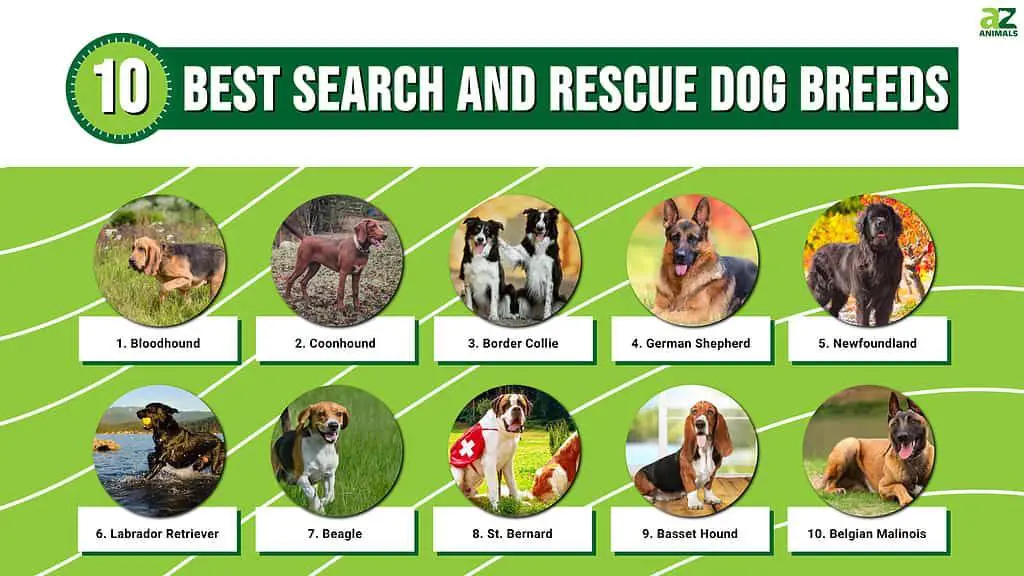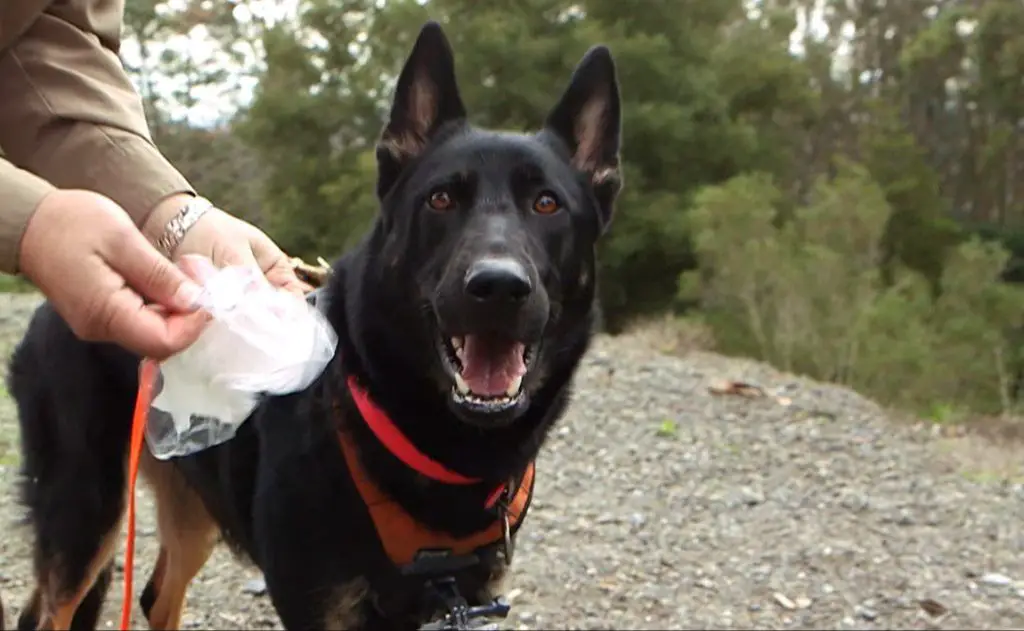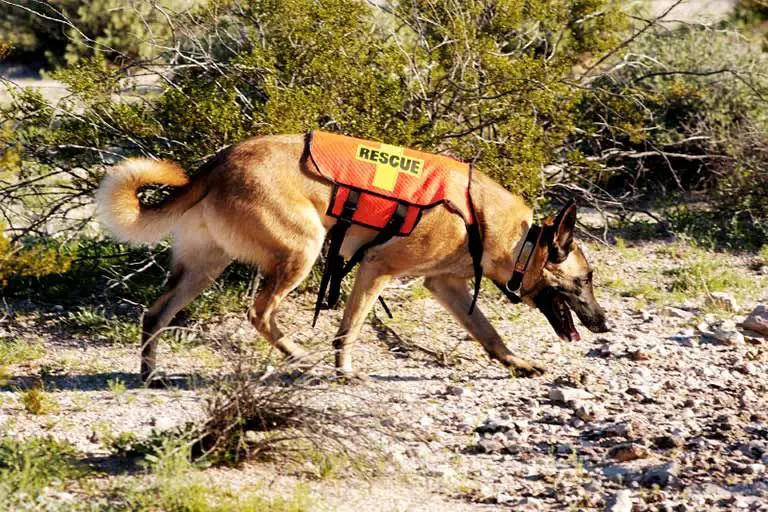Breeds Commonly Used
When searching for the ideal search and rescue dog, certain breeds tend to excel in this demanding line of work. The most popular breeds used in SAR are:
- Labrador Retrievers – With their keen sense of smell, high energy, and eager-to-please nature, Labs make excellent search dogs. They are intelligent, easily trained, and have an innate drive to hunt, making them naturals at tracking scents.
- German Shepherds – Known for their confidence, courage, and protective instincts, German Shepherds are highly capable SAR dogs. They bond closely with their handler and have an intense focus that enables them to search methodically even in difficult terrain.
- Border Collies – Extremely energetic and athletic, Border Collies have the stamina required for extensive search operations. They are focused workers who use their intelligence and problem-solving skills to systematically cover search areas.
- Golden Retrievers – With terrific noses, trainability, and people-pleasing personalities, Goldens are well-suited for SAR. They search eagerly and tirelessly, while remaining gentle and friendly with victims when found.

Other popular SAR breeds include Belgian Malinois, Bloodhounds, Australian Shepherds, Doberman Pinschers, and mixed breeds. No matter the breed, drive, athleticism, trainability, and scenting ability are key traits for success.
Desired Temperament
Search and rescue dogs need to have a specific temperament to be successful at their jobs. The ideal temperament includes:

- High energy – SAR dogs need to be able to search for long periods of time, often over difficult terrain. A high energy dog will be better able to work long, arduous days.
- Focused – When searching, SAR dogs need to be completely focused on their task. They should not be easily distracted by smells, sights, or sounds that are not relevant to the search.
- Eager to please – SAR dogs work closely with human handlers and need to be highly obedient and responsive to commands. A strong desire to please the handler is ideal.
- Environmentally confident – SAR dogs need to be confident working in new environments, around unfamiliar people, noises, animals etc. Shy or nervous dispositions are not well suited for SAR work.
- Intelligent – SAR dogs need to be able to learn new skills, make decisions independently, and problem solve. Intelligence allows them to be trained to a high level.
- Driven – An ideal SAR dog is internally motivated and driven to search. Their drive comes from within, not just from external rewards or commands.
The right temperament allows SAR dogs to search effectively for long periods, ignore distractions, work closely with handlers, and think independently when needed.
Scenting Ability
A search and rescue dog’s scenting ability is arguably their most critical attribute. Their sense of smell is estimated to be anywhere from 10,000 to 100,000 times more acute than a human’s. This allows them to detect scents and follow trails that would be completely impossible for people to discern.

Scenting ability is innate in dogs, but proper training maximizes their potential. Testing protocols have been developed to evaluate dogs’ scenting prowess. For example, the trailing test involves laying a track that is aged anywhere from 30 minutes to a few hours. The tracklayer will leave the start with a scented article. At the end of the track, another unrelated scented article is placed. The dog must correctly identify and follow the tracklayer’s scent while ignoring cross-tracks and obstacles. A passing score means the dog followed the correct scent and found the matching scented article at the end within a reasonable time limit.
Search and rescue dogs can specialize in air scenting or trailing. Air scenting dogs are tasked with locating the source of human scent carried by air currents. Trailing dogs follow ground disturbance and human scent on the ground. Both require extraordinary scenting talent, perseverance, and focus.
Athleticism
One of the key traits to evaluate in a prospective search and rescue dog is athleticism. Search and rescue dogs need high levels of strength, endurance, and agility to traverse all types of terrain in search of missing people. They may need to scale rocky cliffs, navigate dense forests, cross fast-moving rivers, climb over downed trees, and more during search operations.
Strength is important so the dog can haul itself over obstacles and not tire easily on long searches. Powerful legs and a muscular build help a dog scramble up and down steep hills. Endurance enables the dog to keep going even when a search lasts all day or overnight. Dogs with good stamina can keep up the pace for hours without needing prolonged rest breaks.
Agility assists the dog in maintaining its footing and changing direction quickly on uneven ground or when squeezing into tight spaces. A nimble dog can adeptly climb, jump, weave, crawl, and balance as needed during a search. An athletic build with flexibility and coordination contributes to a dog’s agility in the field.
When evaluating search and rescue dog candidates, tests of their conditioning, strength, and agility can reveal which dogs have the sheer physical abilities to take on this demanding role and endure the rigors of search deployments.
Drive
Search and rescue dogs need strong instinctual drives to perform their duties. Key drives that make a good SAR dog include:
- Hunt drive – A strong desire to search for and find people or objects. This provides the motivation to keep searching over long periods.
- Prey drive – The instinct to chase after moving objects. This can translate into enthusiasm for search work and retrieval of objects.
- Retrieval drive – The urge to pick up objects in their mouth and bring them back. Essential for rescue dogs who must locate and retrieve victims.
- Focus and engagement – The ability to remain highly focused on their handler and the search task despite distractions.
- Ball drive – A toy obsession and desire to play fetch. This can be used as a reward during training.
The ideal SAR dog has a balance of strong drives that provide stamina, motivation, and the ability to control their drives when working with their handler.
Training
Search and rescue dogs require extensive specialized training to be able to perform their life-saving work. This training starts when the dogs are still puppies and continues throughout their careers. Some of the key elements of SAR dog training include:

- Basic obedience – SAR dogs need rock solid obedience skills like heel, sit, down, stay, and come.
- Scent detection – Dogs are trained to detect specific scents like human remains, blood, drugs, explosives, and more using their incredible sense of smell.
- Direction and control – Handlers use verbal cues and hand signals to precisely direct the dog’s search efforts.
- Agility – SAR dogs practice climbing, crawling, balancing, jumping, and other agility skills to traverse rough terrain.
- Endurance – SAR dogs build physical stamina through regular conditioning to be able to search for long periods.
- Problem solving – Dogs learn how to independently problem solve to locate victims.
- Communication – Handlers and dogs rehearse communicating in high stress situations.
- Realistic training – Regular training in realistic search scenarios prepares teams for actual missions.
This extensive training is essential for developing the skills and experience SAR dogs need to search disaster sites and wilderness environments to locate missing persons.
Certification
To work in an official search and rescue capacity, dogs must become certified. There are a few major certification organizations that test and certify search and rescue dogs in the United States.
One is the National Association for Search and Rescue (NASAR). NASAR has rigorous standards that dogs must meet in order to become certified. The certification process involves assessing the dog’s scent work abilities, agility, obedience, stamina, and ability to work under stressful situations.
Another major certification organization is the International Police Work Dog Association (IPWDA). Like NASAR, IPWDA’s certification evaluates scent detection work, obedience, agility, and the overall working ability of the dog. Certification must be periodically renewed to ensure the dog’s skills remain up to standard.
The certification process usually takes months of dedicated training and practice before the dog is ready to be tested. Handlers work extensively with the dogs using mock searches and practice scenarios. Certification provides assurance to search and rescue organizations that the dog has the competencies needed for this demanding but lifesaving work.
Age
When it comes to age, the ideal time to start training and preparing a dog for search and rescue work is between 1-2 years old. While puppies under a year may still be too immature, waiting until a dog is older than 2 can make training more challenging as the dog is set in its ways.
Starting SAR training with a dog between 1-2 years allows you to begin working with them once they have a solid obedience foundation, are past the distractible puppy stage, and still young enough to learn new things easily. This age range lets dogs mentally and physically prepare for the demands of SAR work.
Within this ideal 1-2 year old range, many trainers prefer to start closer to 1 year if possible. Beginning SAR training with a younger adolescent dog allows you to shape their early development and set them up for success as they grow. The key is finding the sweet spot where the dog is focused enough to seriously start SAR education, but still impressionable enough to learn new skills quickly.
Careers for Search and Rescue Dogs
Search and rescue (SAR) dogs have a number of career paths helping locate and rescue missing people.
Wilderness SAR Dogs: Wilderness SAR dogs use their exceptional scenting ability to track lost hikers, hunters, children, and others who become lost in forests, mountains, and other wilderness environments. Their tracking skills combined with endurance allow them to cover a lot of ground even in difficult terrain.
Disaster SAR Dogs: Disaster SAR dogs search for survivors in the aftermath of disasters like earthquakes, hurricanes, tornadoes, and floods. Using their scenting skills, they can locate people buried under rubble or stuck in wreckage.
Human Remains Detection Dogs: Also known as cadaver dogs, these dogs search for human remains. Police utilize them to find missing persons or search crime scenes. Archaeologists may use them to locate ancient burial sites.
Avalanche SAR Dogs: Avalanche SAR dogs have the demanding job of finding skiers, snowboarders, and others buried by avalanches in the snow. Speed and scenting accuracy are critical.
Water SAR Dogs: Water SAR dogs use their swimming strength and scenting skills to find drowning victims in lakes, rivers, oceans, and other bodies of water.
Search and rescue dogs have an amazing ability to save lives using their athleticism, intelligence, and scenting skills. Choosing a SAR career path allows dogs’ natural abilities to shine.
Adoption
Many search and rescue dogs retire from active duty once they reach 8-10 years old. At this point in their lives, most SAR dogs still have plenty of good years left and make excellent pets. Their advanced training and experience enables them to transition smoothly into family life after retirement.
There are a few ways to adopt a retired SAR dog. Some SAR organizations have their own adoption programs to rehome dogs once they retire. You may be able to adopt directly through the organization the dog worked with. There are also some SAR dog adoption groups specifically focused on finding new homes for these working dogs.
The ideal home for a retired SAR dog is with an active family familiar with high-drive working breeds. While ex-SAR dogs are usually more mellow in their senior years, adopters should be prepared to provide adequate daily exercise and mental stimulation. These intelligent dogs need proper care and attention to thrive in retirement.
Before adopting, ask about the dog’s health and any special needs. Make sure your lifestyle and energy level are a good match. While an ex-SAR dog will bond closely with you, extensive retraining is not necessarily required as they are highly disciplined. With patience and care, one of these heroic dogs can make a wonderful pet in their golden years.